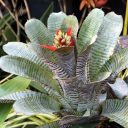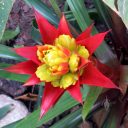Bromeliads Make Great Orchid Companion Plants
Bromeliads don’t have the fame and glamour of orchids, but they’re fascinating, beautiful, and easy to grow. Some have otherworldly flower spikes, with remarkable shapes reminiscent of exploding fireworks or fantastic creatures. Others have foliage with spectacular variegation that provides year-round color. Bromeliad flowers are often tiny and fleeting, but their stunningly colorful bracts can be large and durable. Most are denizens of tropical rainforests in Central and South America, living alongside orchids in the wild. Famous bromeliads include pineapples and Spanish Moss.
Some types called tank bromeliads have rosettes of overlapping leaves which hold water. There are varieties with spines along their leaf edges, and others which are succulent desert plants. Among the most popular bromeliads, Tillandsias are shown in the next three photos below. They’ve become popular houseplants, often simply called “air plants.” As epiphytes, they live up in the trees with orchids. They can be grown in pots or on mounts, or as bare plants living in a bowl or on a table.
I’ve tried to illustrate the wondrous diversity of the bromeliad family, but there really is so much more. About 3600 bromeliad species range throughout Central America, South America, and the southern USA, with one species native to West Africa. There are also many hybrids. The most commonly sold types need care similar to tropical orchids: mild temps, regular water, bright light, good humidity, and air movement. There are also cool growers, like this Billbergia tank bromeliad which lives outdoors all year in our Northern California garden. Its brilliant flowers stand out, even among the orchids.
Explore posts in the same categories: General Gardening, Photos
Subscribe to the About Orchids Blog:
![]()














